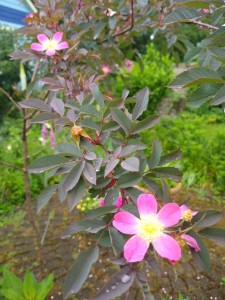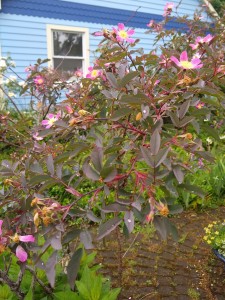 I first saw Rosa glauca, sometimes known as Rosa rubrifolia, in a dreamlike setting. The large shrub was growing at Stonecrop in Putnam County, New York, former home of the late Frank Cabot, founder of the Garden Conservancy. The day was overcast and fog shrouded parts of Cabot’s magnificent garden. I came around a corner and saw the rose with wisps of mist clinging to it. The bush was tall, with arching reddish-purple canes and blue-gray-green foliage. It was not in flower, so I hadn’t a clue about the blossoms, but the plant was both majestic and mysteriously beautiful. I was hooked.
I first saw Rosa glauca, sometimes known as Rosa rubrifolia, in a dreamlike setting. The large shrub was growing at Stonecrop in Putnam County, New York, former home of the late Frank Cabot, founder of the Garden Conservancy. The day was overcast and fog shrouded parts of Cabot’s magnificent garden. I came around a corner and saw the rose with wisps of mist clinging to it. The bush was tall, with arching reddish-purple canes and blue-gray-green foliage. It was not in flower, so I hadn’t a clue about the blossoms, but the plant was both majestic and mysteriously beautiful. I was hooked.
The rose was also unlabelled, so it took some research to find its identity. Thanks to my library of rose references and the enormous bounty of the internet, I was able to identify the mysterious beauty as Rosa glauca. I found a source online and ordered one immediately.
People, including me, usually fall in love with roses for their flowers. Occasionally they are drawn to unusual or showy hips, like the cherry tomato-esque hips of thorny Rosa rugosa. I have never heard of anyone falling for a rose because of its foliage—except for people who have seen Rosa glauca.
The old and new Latin names tell the tale. “Glauca” refers to the powdery leaf coating that helps give the leaves their distinctive color, soft appearance and singular aura. “Rubrifolia” is a reference to the reddish cast of the stems and leaf veins.
Rosa glauca is not noted for its flowers. Like many species roses, the plant blooms only once a year, usually in May in my part of the world. The medium pink flowers are single and about an inch wide, with only five petals apiece and centers filled with golden stamens. Every year the blooms appear along the stems like stars—not clustered, but shining individually in a graceful array. Some sources describe the blooms as “lightly scented”. I can’t really pick up much scent at all, but that may be because the flowers are spread out on the plant. Sadly, those flowers disappear relatively quickly, replaced by small red hips that remain during the summer months.
If you were pessimistic, you might say that Rosa glauca has all the traits that make modern gardeners turn away. It is statuesque, with a mature height of six to eight feet, and a spread of five to seven feet. This is not ideal for small space gardening, though you might grow it successfully in a large container. As a once-bloomer, it does not pull its weight in the flower department. The beautiful canes and arching configuration provide great winter interest, but most people seek winter interest from more obvious sources like evergreens or exfoliating bark or masses of bright berries.
But I am not a pessimistic gardener. My Rosa glauca is taller than I am, but I grow it in standard or tree from, bolstered by an unobtrusive support. That makes it easier for me to use it as part of a mixed border, underplanted with all kinds of perennials. Frank Cabot endorses this treatment in his excellent book, The Greater Perfection, saying, “It’s hard to improve on Rosa glauca as a companion plant.”
Clearly my plant is happy with its companionable situation. Last year I noticed a bit of blue-gray-green foliage opposite my mature Rosa glauca. It was clearly an offspring announcing its arrival in the world with a single, hopeful new cane. Eventually I will have to move it to a different position, but for the moment I just take pleasure in its appearance.
Rosa glauca is native to northern Europe, which probably explains its exceptional cold tolerance. This may be why it was chosen as one of only a handful of rose species and varieties planted on New York City’s High Line, an elevated public garden that is exposed to wind and weather.
Like all other roses, Rosa glauca appreciates rich, well-drained soil, consistent moisture and a nice blanket of mulch over its feet. It does not really need pruning, except for the removal of dead or damaged canes.
If you want to buy Rosa glauca now, you may have to wait a bit. Several of the better mail order nurseries carry it, but are out of stock right now. This may change in the fall. To put your name on the availability notification list, get in touch with Digging Dog Nursery, 31101 Middle Ridge Road, Albion, CA 95410; (707) 937-1130; www.diggingdog.com. Print catalog $2.00.
Several years after I first saw Rosa glauca at Stonecrop, I met Frank Cabot, who was one of the grand old men of American horticulture. He and I had a brief conversation about the rose and  I asked him to inscribe my copy of his book. His inscription reads, “Long life to those who enjoy gardens and grow Roas glauca.”
I asked him to inscribe my copy of his book. His inscription reads, “Long life to those who enjoy gardens and grow Roas glauca.”
